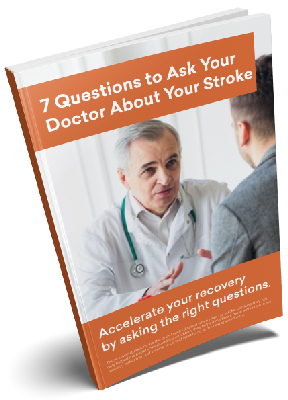NEOFECT Home takes tedious stroke recovery exercises and infuses them with fun and interactive games, which exercise your brain & muscles simultaneously to expedite the rehab process.
Highlights:
04:04 How it started
06:45 The Smart Glove
11:04 Repetition
13:58 This wasn’t possible
17:16 Cost
21:44 Testimonials
Transcript:
Scott Kim 0:00
The main thing when it comes to neurorehabilitation, the most important thing is repetition. Like the more use it, like, you know, the less you lose it. So like you have to, like keep doing, you know, repetitive motion over and over.
Scott Kim 0:16
It’s kind of boring. But at the same time, people always have two questions. So how much like did I get better? And then they have much like, you know, like am I doing compared to like two months ago.
Scott Kim 0:28
So by being able to measure all the range of motion, by it able to tell you that like you know, the progress that you’re making.
Intro 0:39
This is recovery after stroke with Bill Gasiamis helping you go from where you are to where you’d rather be.
Bill 0:48
Bill from recoveryafterstroke.com This is Episode 74. And with me is Scott Kim from Neofect. Scott, welcome to the podcast.
Scott Kim 1:00
Yeah, thanks for having me, Bill.
Bill 1:01
Yeah, thank you, man. I thought I’d get in touch because I get excited when I find new products that can help stroke survivors and anyone else who’s experiencing neurological challenges.
Bill 1:13
And one of your products stood out but before we get to talking about that product, can you tell me a little bit about how it is that you got involved in the organization that you’re working for? And how did that lead to the development of these amazing products? Tell me what it is that you do.
Scott Kim 1:33
Sure, yeah, as you said, Neofect is a company that makes software and hardware and for you know, like that to help the you know, people with the like neurological conditions, and our flagship device is called the Smart Glove.
Scott Kim 1:54
And you can use the glove as you know, like a rehabilitation tool after stroke or traumatic brain injury or spinal cord injury at home, so the main idea is that the rehab can be more engaging. So like you’re given, like a tablet that has like, a bunch of you know, like the software.
Scott Kim 2:20
And once you wear the glove, then, you know, the glove actually like works as a virtual controller. So you play games, such as Squeeze Your Orange play ping pong, or catch a baseball, but at the same time, you’re going through the clinically proven rehab process, like by playing games.
Scott Kim 2:39
So yeah, and then you get paired up with our, you know, clinical managers, they can, you know, give you a lot of coaching about like, how to use the product, and then so that you can just like, you know, rehab yourself for fun in the comfort of home.
Bill 2:57
Tell me a little bit about how is it that you got involved. In that type of organization, what led you to that path? How did you start?
Scott Kim 3:06
Yeah, so I was one of the founders of this company. I was actually in business school at the University of Virginia Darden School of Business. And I met a friend of mine, who had a lot of ideas. And this was like one of actually, this was like one of his friend’s ideas.
Scott Kim 3:27
But my friend who was in, you know the same class at Darden University. In MBA class was pretty emotional about the stroke. So his father actually, like passed away from a stroke. And it already had been almost a decade, but he still like, felt bitter about it.
Scott Kim 3:49
And his friend had an idea about this. It’s like we can make the stroke we have more fun, just because he was, you know in USC University Southern California, He was like, basically studying this kind of topic.
How Neofect started
Scott Kim 4:04
And I got involved by meeting these guys. And I was also personally attached to the idea because I was born with the spinal bifida which is a type of disability that, you know, anyone can be born with, you know, like that affects, the rest of your life.
Scott Kim 4:22
Luckily, I was like mild case, but I went through major surgery and I had a fair share of rehab growing up in South Korea. And, rehab was not fun. And I always thought I could be a lot better.
Scott Kim 4:36
So as soon as I heard the idea, I was like, yeah, this can change, you know, like the way that rehabs take place, right?
Bill 4:45
Yeah. It started as an idea from somebody who had experienced a stroke in their life because their father passed away. Then it developed by wanting to make rehab more fun. But then how did you come up with the idea to develop a product?
Bill 5:05
Or how does that go from let’s make this more fun to the product that we’re going to talk about, which is the glove, which is called a Smart Glove right?
Scott Kim 5:15
Yeah. So we, like before we started developing, we just wanted to make sure that we know what we’re talking about, right? It’s like, my friend had like, severe failure that, you know, like with the startup before business school, so he had a lot of doubt.
Scott Kim 5:37
And I was also super curious about the situation in the States because I have direct experience with the rehab setting, but that’s like, you know, early 80s in South Korea, and it’s not even the same country, over there.
Scott Kim 5:51
So that was like 2010 in America so I thought this kind of thing might already exist. So we did a lot of like market research, buying, you know, talking to therapists or talking to clinicians, and we realize that you know, surprisingly, it’s kind of the thing.
Scott Kim 6:08
Like, you know, the thing that I went through in South Korea early 80s is not too different from you know, like 2010 in America. So I was like, Okay, this might be a helpful invention for people who need rehabilitation.
Scott Kim 6:23
So once we realize that we started recruiting the, like software engineers, so you can actually make the contents and then just wanting to make sure that the device, becomes something usable.
Bill 6:38
Yeah. So what is the device what does it look like? How do people use it?
The Smart Glove
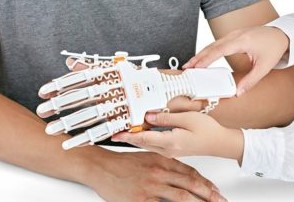
Scott Kim 6:45
So the Smart Glove itself like it just looks like you know, like the glove for gaming and it’s super lightweight, it’s only it’s less than four ounces which is lighter than your iPhone. And the glove mostly it’s made out of like silicon.
Scott Kim 7:03
So it doesn’t feel too heavy. And once you wear the clothes and the softer actually can detect like all different types of motions or it’s six motions including, you know, like just opening and closing your fingers but at the same time, you know like hand shaking motion and then same thing without gravity and also like (inaudible) and palm up palm down.
Bill 7:37
So when I had a look at the glove It reminded me of an exoskeleton now just because of the way that it’s designed and looked at you wouldn’t happen to be wearing one would you?
Scott Kim 7:51
Yeah, exactly. I mean a lot of people say like, exoskeleton when they see the glove looks like this. It’s made up of plastic and silicon it’s pretty lightweight lighter than your iPhone.
Bill 8:05
Yeah, awesome. And in the glove in that section where the fingers are the sensors what type of information does it take back from the hand?
Scott Kim 8:14
Yeah, that’s a great question. The Smart Glove has two parts of sensors you know, Number one, these are the bending sensors. So, it’s like the exterior material is made out of like silicon. So, you can bend and once you start flexing your fingers then all the data are just like on a real-time basis like you know, transmitted to software.
Scott Kim 8:42
So the software or the games can detect how much bending each finger makes right now. And the second sensor is the main gyro sensor and this part has a sensor. So this mainly detects like the motions like, you know, Thumbs up, thumbs down, or like a handshake, motion. (inaudible)
Bill 9:14
So basically what it’s doing is it takes that information, puts it on a screen, and then allows the software to, for example, grab a ball, throw a ball, or let go of the ball, something like that.
Scott Kim 9:30
Similar, so it’s active. It’s all about active range of motion, The software can’t control, the motion, but it measures how much of a range of motion you’re having or your you’re moving your hand.
Intro 9:52
If you’ve had a stroke, and during recovery, you’ll know what a scary and confusing time it can be. You’re likely to have a lot of questions. going through your mind, like, how long will it take to recover? Will I recover?
Intro 10:06
What things should I avoid? In case I make matters worse, doctors will explain things. But, because you’ve never had a stroke before, you probably don’t know what questions to ask. If this is you, you may be missing out on doing things that could help speed up your recovery.
Intro 10:22
If you’re finding yourself in that situation, stop worrying, and head to recoveryafterstroke.com where you can download a guide that will help you. It’s called seven questions to ask your doctor about your stroke. These seven questions are the ones Bill wished he’d asked when he was recovering from a stroke.
Intro 10:41
They’ll not only help you better understand your condition. They’ll help you take a more active role in your recovery. head to the website now, recoveryafterstroke.com and download the guide It’s free.
Repetition and hand therapy
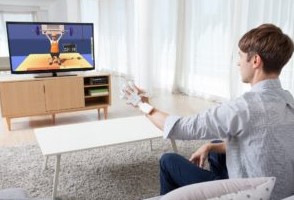
Scott Kim 11:04
The main thing when it comes to neurorehabilitation, the most important thing is repetition. Like, the more you use it, the less you lose it. So like you have to, keep doing repetitive motion over and over. It’s kind of boring.
Scott Kim 11:21
But at the same time, people always have to question so how much did I get better? And then they how much like, you know, like am I doing compared to like two months ago.
Scott Kim 11:32
So by being able to measure all the range of motion, it can tell you the progress that you’re making, but at the same time, every time that you’re making any motion with your hand, it tells you that you know, how great your range of motion is.
Bill 11:51
Yeah, okay. So what it’s doing is it helps you see the baseline where I started. After I’ve used it for an amount of time, how far I’ve come?
Bill 12:05
That’s a really good thing because that’s what a lot of people recovering from neurological issues need, they need to know, that I’ve come a certain way with effort and repetition. If I continue to do that, I might notice more results I might get more movement and function.
Scott Kim 12:23
Yeah, and also like, it tells you how reactive you are, you know, because I there’s a lot of cues like happening now, like, the software is telling you like catch the baseball right now. And when the ball is coming at your hand, with the right timing, you should be doing this.
Bill 12:45
Yeah, and it’s not a real baseball. It’s a virtual baseball on a screen. It’s coming at you that you can see. And then I imagined that you can manipulate how fast and how slow the baseball goes.
Scott Kim 13:00
Technically doable, but that specific game does not do it. But what you can do with most games like in our software is you can play around with the difficulty. So for example, as you know, there’s a lifting game, and then once you lift your wrist it’s measuring how many seconds you’re holding this way.
Scott Kim 13:32
And then instead of like, you know, trying a 15-second challenge it’s like you can like to make it 25-second challenges you can play around with the difficulty.
Bill 13:46
Yeah, wow, man. I get excited I just have to say to you as soon as I heard that products like these are available I needed to find out about them. I need to understand them I need people to know that they exist.
This wasn’t possible
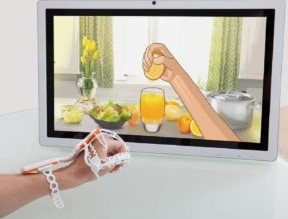
Bill 13:58
When I had in stroke seven years ago, with my stroke journey, this wasn’t possible. Or these things didn’t exist. What is it that’s made a lot of these things possible now, I’m seeing a lot of different versions of something similar out there. Is it just that technology has moved forward?
Scott Kim 14:21
Yeah, I think so. I mean, like, I think it is a technology that moves forward. But my view is that healthcare is not necessarily always the pioneer, like trying new things or bracing the technologies. And especially like rehabilitation, like that’s like this story, even in the same healthcare sectors.
Scott Kim 14:51
So I think finally, like past, I would say, past like, you know, 5-10 years like, there has been lots of technology like getting into healthcare, especially like rehab.
Scott Kim 15:04
So, I mean, can we reuse like apps iPhone, like all the time daily, but you know, not the same way in be upsetting but I, I see like the trend that’s like embracing more technologies in this field.
Bill 15:21
Yeah, that’s such a good thing, man. It’s needed. And I remember when I was in rehab in 2014, they did have a little bit of rehabilitation that I did for my left hand, which was with the Wii, Nintendo Wii.
Bill 15:39
And I was playing a tennis game. Now I have ranged I’ve got a good range of motion my hand my hand, although it feels like it prefers to stay closed.
Bill 15:51
And actually, very easily stays open. So I was easily able to hold on to the Wii controller and play tennis. And I’ve got to say that I looked forward to doing that in rehabilitation because the only thing that was more stimulating than putting my hand in the bucket of rice to find.
Bill 16:15
To find the pencil or to find the (inaudible) stuff, you know, so it’s something I look forward to now this glove, how long has it been in development?
Scott Kim 16:30
We spent four years like for R&D, and I mean, like smaller startup back then, it’s like we had a lot of obviously you know, like, you don’t have like tons of resource. So we had a lot of ups and downs, but like, eventually it took us four years.
Bill 16:53
Yeah, well, Scott, how much does it cost for somebody to get a hold of the glove and the software package that’s involved now just for everyone listening and watching so that they know, I don’t have anything to do with your organization?
Bill 17:07
I don’t get any money from it. (inaudible) loves to share it. (inaudible) motion. So how much does it cost for somebody to get a hold of?
Cost of Neofect
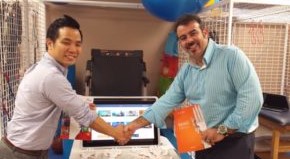
Scott Kim 17:16
Yeah, in the United States, it costs, about $2,000, to buy the device, and it comes with a tablet that has the software. And yeah, and there’s like, you know, like a payment plan, you know, monthly payment plan, which eventually, you know, like, as a little bit more.
Scott Kim 17:37
But it’s more flexible, but yeah, to buy like, it’s currently it’s about like $2,000 and we’ve been on the market in the United States since and we started like selling it to like, you know, home patients or home customers like since 2017.
Bill 17:54
Right, so, are you starting to see that there’s some uptake in the rehabilitation hospitals and the therapy hospitals?
Scott Kim 18:02
Absolutely, yeah. So a lot of the larger hospitals in the states like you know, NewYork Presbyterian or like New York University or Stanford and like, you know, you name it, like a lot of like major hospitals like they studied, you know, they’re our customers now.
Scott Kim 18:18
And then Stanford University has already like published, you know, like research paper about, you know, like about our home device. And there’s like, you know, more research going on by Stanford too.
Scott Kim 18:30
So, yeah, lots of like, we have settings you know, have been like welcoming our devices and software. And yeah, it’s been a very enjoyable ride.
Bill 18:41
Is it available in other countries outside the United States yet?
Scott Kim 18:46
For the Home program, pretty much the US is the only country that we’re doing and like because of many reasons, but we do have the devices, I mean, just like, you know, like how you remember about, you know, how you rehab, you go to the hospital?
Scott Kim 19:06
And then you know, they do have like their devices. So like for hospital sales sure, yes. And besides the United States like, you know, European countries and like Western European countries (inaudible) Korea where we study our operations (inaudible) and it’s pretty big in Japan too. And a little bit of China. Yeah, lots of other countries.
Bill 19:34
Well, doesn’t sound like you’re doing much yet in the Asia Pacific area. So when you finally get that get that far away and I understand the world is a big place like I get it right. (inaudible) Far away, that’d be amazing.
Scott Kim 19:48
Yeah, we like actively thinking about it. It’s completely my ignorance, but I didn’t know Until we studied like having this discussion I never knew how far Australia and New Zealand are.
Scott Kim 20:10
I mean my wife like you know went to high school in New Zealand I should know better but it’s kind of hard but we’re always interested in you know that area and then there has been quite a bit of constant interest coming from there. So I love to like visit, you know, like New Zealand and Australia one day.
Bill 20:35
Scott, I think maybe we can get the ball rolling down here. I’ll share it with everybody I know I’ll tell everybody that so they can put some pressure on you to get more active in this space, but I completely understand what you’re doing.
Bill 20:51
So there are no dramas on my end. I understand. If somebody decided that they did though. who’s listening wants to buy it This is a worldwide podcast. Where would they go to get more information about the product?
Scott Kim 21:06
Sure. It’s new neofect.com like N as in Nancy NEOFECT.COM
Bill 21:20
Yeah. Awesome so the gloves are around $2,000 People can order them from neofect.com or ask questions or get in touch with you guys I see some amazing videos actually of people using them. Tell me about some of the people who have had results with it what sort of feedback have you been getting?
Perfect Neofect Testimonials
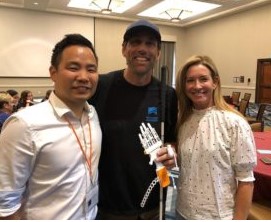
Scott Kim 21:44
Now that we have like, you know, thousands of, you know, like home customers in America. We have a lot of testimonials and recently one guy had a massive stroke and he was a bus driver at the airport.
Scott Kim 22:11
So you mean you see the like drivers that load passengers moving them from one terminal two parking lot and he was one of those drivers and then he apparently like after stroke he paused his work a little bit but he sent us a thanks note like saying that now I’ve been using your device and I got back to my job and then with some nice photos too.
Scott Kim 22:47
His main thing was like he wanted to be able to use the gear for the bus and for that action I mean for usually like for anyone who’s not aware of stroke, like, they don’t understand how challenging you know, like just like closing fingers like the action of closing fingers or even move your hand that locate it onto something like how challenging it is like they don’t know.
Scott Kim 23:18
But this guy, his main thing was being able to use the right hand like to the gear because that was the effective hand. And then he was like thanking us saying that like using your device like very constantly, that I was able to do progress and numbers but at the same time, most importantly that he got back to his normal job.
Scott Kim 23:38
So things like this, like it’s very rewarding for me. And, you know, I was also the one who could deal with my physical challenges growing up.
Bill 23:49
Yeah, so you’re somebody who can relate to what somebody with a disability is going through because you’ve been through that and it’s amazing that a lot of people have experienced neurological conditions or some other kind of form of disability.
Bill 24:05
So motivated to find solutions, and it’s a really strange thing because I’m glad that you went through that to discover, you know, this creative part of you that enables you to create the solutions. But of course, I rather you didn’t have spinal bifida or other people didn’t have a stroke.
Bill 24:22
But we do. It’s just so good that we put our focus into these amazing tasks because it’s so needed and there’s not enough work out there. And we know that doctors and therapists do their best to help us and that’s what they devote their life to, and I’m ever grateful for that.
Bill 24:41
But it’s always a little better to get somebody that’s on your team who’s been through the same journey that you’ve been through or something similar. What I’m saying is man, thanks so much for doing what you’re doing.
Scott Kim 24:53
Oh, thank you!
Bill 24:57
I appreciate it will share this far and wide and get some cool images of the glove that you’re wearing online to support that and get some links back to people who want more information.
Bill 25:13
Also, if somebody happens to be listening to this on the podcast app, or their favorite podcast app jumped on the YouTube channel, I’ll have a link to the YouTube video where they can see you wearing the glove and see what it looks like because that’s a cool thing to see.
Scott Kim 25:31
Well, thank you.
Bill 25:34
Scott Kim from Neofect. Thanks so much for being on the podcast.
Intro 25:40
Discover how to support your recovery after a stroke. Go to recoveryafterstroke.com






